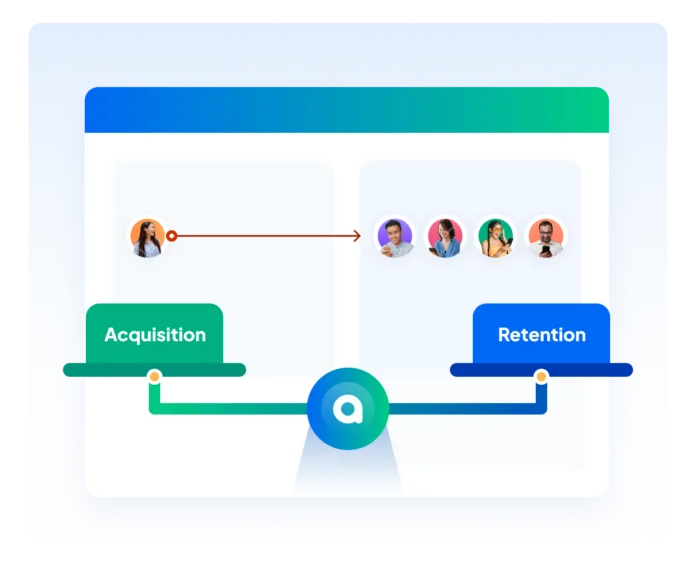
Imagine you are at a gun range, trying to hit a target 50 yards away.
What do you need to ace this shot? Yes, you are right – Focus & a proper Trigger that helps you shoot.
Customer segmentation provides ‘Focus’ to your business’ marketing, and target marketing is the trigger that right message to the right customer at the right time.
Without customer segmentation, you are just firing a machine gun in all the directions, not only missing all the targets but also wasting your valuable bullets.
According to Mckinsey report, retail brands that run campaigns tailored to different audiences score up to 5% more sales.
What is Customer Segmentation & Target Marketing
Customer Segmentation provides insights into the landscape of the market by building customer characteristics that can be used to group customers into segments that have something in common. These segments can be formed based on the customer’s demographics, geographic location and buying bahaviours.

Once you have our customers segments, you can concentrate your marketing efforts on one or a few key segments consisting of the customers whose needs and desires most closely match your product or service offering. This is called target marketing.
Benefits:
- Higher customer satisfaction rate: Streamlined marketing activities cater to the consumer’s specific needs & wants, resulting in a higher customer satisfaction rate
- More Engaged customers: As your customers gets the right and personalized message in right time, they feel more connected to your brand or business. Read more about how to better engage your customers.
- Lower marketing costs: the resources and efforts are not wasted on broadcasting or reaching and pleasing everyone; instead, selected sections of the consumers are approached who feature the tendency to consume or buy the product and services.
- Increase business revenue: targeting the right customers with personalized messages means maximizing results with minimizing the marketing efforts, hence increasing the revenue.
Why you need Consumer Engagement Strategy in 2022

According to a study by Media Dynamics, an average adult who is exposed to thousands of brands in the market, engages with only 12 brands at a time. If you want to be one of the brand that your target customer engages with, you need to worry about your engaging your customers today!
Amongst the hundreds of benefits that a good customer engagement strategy can bring for your business, we emphasise on the top 2, for this article:
- Consumer engagement creates stronger connections and loyalty with your customers. The more you engage with your customers, the more you give them the opportunity to know who you are, and connect with your brand. This increases your brand recall, and the likelihood of purchasing again.
- Consumer engagement helps build a strong brand mindshare. When your brand consistently engages with your customers, it helps to establish your brand’s image in your customers’ mind. This is called building your brand’s mindshare – which is extremely important for any business.
- Consumer engagement provides more chances to upsell and cross-sell. With a robust customer engagement strategy in place, you will better understand the specific need of a customer that allows you to personalise and recommend products and services. This provides increased value to your customers, and in turn, a better customer lifetime value (CLV) and revenue to your business.
Consumer Engagement Strategy Tips for Singapore SMEs: 5 Steps that Work

Finally we have arrived at the section that you have been waiting for. So we will straight jump into the 5-step strategy that every B2C business can follow for an easy strategy that works:
STEP 1: Define your goals & KPIs
For a winning engagement strategy, every element of your planning must contribute towards your vison for the business. Key Performance Indicators are quantifiable goals that help you to track and measure success. They ring the bell when your results are not satisfactory.
STEP 2: Segment your audience
Segmenting your audience is the process of dividing a large audience into smaller groups or segments, those who have similar needs or characteristics. You show potential customers what they need to see to make a purchasing decision based on where they are in the customer journey. This way, your marketing feels more personal and specific.
Example: A fashion retail business that wants to clear their old stock of formal clothing will get the maximum benefit if they will target women of age group 25-45 years. To even narrow down, they can also add additional filter of women who have spent at least, say $500 with this brand in last 6 months. Because, these are likely the most loyal customers of this brand and have more possibility to make a purchase based on their history. This also gives this business a chance to invite their most loyal customers first and strengthen their relationship with them.
This whole process of segmenting huge customers data can be complex. A smart CRM can help you automate this, so that you spend your time and resources on working on right strategies. You can check Advocado’s smart-CRM features here.

STEP 3: Strategise your engagement campaigns in advance for every audience segment
Based on your audience set and business objective, determine the engagement strategy for every segment.
Example: Restaurant ABC has the objective of increasing customer visits and revenue for the year 2022. This is how they can strategies campaigns

It would be interesting for you to check out how One Futureworld, the premium reseller of BOSE music system in Singapore aced their consumer engagement with Advocado!
STEP 4: Maintain your campaign calendar based on goals & strategies
Your engagement strategy should help your business to lead and not follow. Its best if you make your strategies in advance on quarterly, half-yearly or even on annual basis. Creating an internal calendar will help you execute these strategies in the right time.
Answers to some of the below questions will help you plan your calendar better
- How often do you want to run the campaigns?
- When do you want to execute these campaigns?
- What is your target audience for each campaign?
- Is your offer/campaign enticing for your customers?
STEP 5: Track your results and make improvements
You can only improve if you know how your campaigns are performing. Track the results and compare with your goals and KPIs. The most responsive target audience can be targeted with more offers and campaigns. Also, the better performing campaigns can be repeated, while the not performing ones can be terminated.

